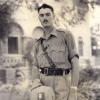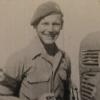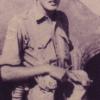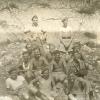Tony Hibbert’s father, James Edmund Hibbert was a rubber planter in Malaya when WW1 started. He sailed for England and was commissioned into the South Lancashire Regiment. Severely wounded in 1917, he joined the Royal Flying Corps and ended the war as a Squadron Leader with an MC and 2 Bars, a DFC and was twice Mentioned in Despatches. In 1916 he married Margaret Judkins, a daughter of the church and of a family of artists. Tony was their first child, born in 1917.
Educated at Marlborough, Tony had to leave when he was 16 because of the Great Depression. Joining a London Wine Merchant which imported German Wines, he was sent to Germany to learn the language and something of the trade. Living with the family of the Gauleiter for Bavaria of the NSKK, it seemed to him that Germany was one huge armed camp preparing for war, probably within the next 3 to 4 years. The 2 boys of the family were in the Hitler Jugend, a sort of military Boy Scouts. When Tony found that for their evening prep they were in charge of a Motor Cycle Section developing plans to advance on Paris he packed his bags and skedaddled for home in 1935, threw up his job and started to cram for the Royal Military Academy (RMA). His father told him he was mad, that Germany had such a pasting in WW1 that they would never go to war again in his lifetime. He cut Tony off without a penny and refused to speak to him again till he got back after Dunkirk.
British Expeditionary Force and Dunkirk (Operation Dynamo)
Tony passed out of the RMA and was commissioned into the Royal Artillery In January 1938. War started on 3 September 1939, as Tony had predicted and he landed in Cherbourg on 9 September commanding a half-Battery of 15 AA Battery RA with the British Expeditionary Force. His Battery was equipped with guns salvaged from a Russian Cruiser in Odessa in 1917 still with the Cyrillic inscriptions on the breech blocks. The guns were not fit for purpose but got Tony out of one tight corner. He defended the Northern perimeter of Dunkirk for the last four days of the siege and when his ammunition ran out on 31 May he had to destroy his guns. Night had fallen and he was ordered to lead his remaining troops out into the shallow shelving bay to find the small boats which were waiting to take them to the ships in deep water.
“A yellow-green iridescent film covered the waters of the huge Bay of Dunkirk. 20 ships sunk with their backs broken were still on fire in the foreground, and the flames of Dunkirk’s massive oil tanks reflected downwards from the black clouds above into the sea of phosphorus below. The criss-crossing streams of multi coloured tracer lit up the sky – ours reaching up to find the German planes, theirs descending to find us. There was an ear-drum shattering constant thunder of aerial bombs and artillery shells and when they landed round us in the shallow water the fragments performed myriads of outspreading “ducks and drakes” in lines of green and yellow fire as they touched the phosphorus. This was a Wagnerian setting of Gotterdammerung on a truly Olympian scale. I have never seen anything so beautiful and breathtaking in my life. My mother, a Wagner devotee would have loved it, though possibly in a quieter setting at Glyndebourne with a bottle of champagne waiting on the lawn. But as an artist what a fantastic Turneresque painting she could have bequeathed us.
In the deep water we found an old Thames Tug, ‘Sun X’ waiting for us. How we cheered. None of our men had slept for four days and the moment they got on board they all went into a deep coma in spite of all the bombing; one of the bombs almost lifted the tug out of the water but not one of my men even turned over in his sleep. Eventually we reached Ramsgate and within minutes of disembarking the old ‘Sun’ had turned round for another of her mercy runs, followed by our grateful cheers. With only one rail siding on the dock and with ships coming in almost every minute, the military police were herding the men like cattle regardless of rank or unit and were turning round these trains about one every five minutes.
Hordes of women volunteers were trying to get every soldier a cup of tea and were handing out pre-printed cards saying
‘ -------------------------------has returned and is well and will contact you as soon as possible. signed--------------------------.’
All you had to do was to write your name and sign it and give the name and address of your next of kin on the back. With no stamp needed, the volunteers posted them immediately. God bless those women, they treated us as heroes. We knew and they knew that we had just taken part in the greatest cock up in military history since Hastings and that we could expect much worse to follow. We felt we had let them down, but to them we were their sons come back to protect them in their homes and our men began to recover their pride and feel like men again and found again their wonderful resilient sense of humour.”
Tony Joins The Paras
It took 10 days to collect the survivors of the Regiment in Aberystwyth, albeit armed with rifles and revolvers only. It seemed to Tony there was no chance of receiving any artillery weapons before the inevitable arrival of overwhelming numbers of German troops supported by an invincible air force. Even the presence of the Summer Camp of the Chelsea College for Young Women in the hills above Aberystwyth provided little distraction. “If the Germans landed in England there was nothing to stop them and the great British Empire would become a fief of Nazi Germany.” Of the three subalterns in Tony’s Battery all volunteered to join anything that would get them back in the firing line quickly -- one joined the RAF and commanded a famous Rocket-Typhoon Squadron which later caused Tony much grief by attacking his base in Holland for three consecutive days; one joined 4 Commando and won a VC at Dieppe; and the third (Tony) joined No. 2 (Parachute) Commando, the egg out of which the Parachute Regiment was born. While serving with No 2 Commando, Tony performed a night jump from the balloon in full mess kit and spurs! A fact attested by both Cicely Paget-Bowman and Arthur Kellas. (See further article on Tony’s time with No 2 Commando and 11 SAS.)
Arnhem
Tony served with the Paras in North Africa and Italy as a Staff Officer and after completing a course at the Staff College, Camberley, was posted to the 1st British Airborne Division as Brigade Major of 1 Parachute Brigade in July 1944. Soon after he was involved in planning for the Arnhem Operation and went to Airborne Corps HQ with his Brigade Staff to receive orders from General Browning. After the briefing, Tony and the four Brigade Majors were taken to the office of the Corps Intelligence Officer, Major Brian Urquhart (who later became Under Secretary General United Nations). He outlined the intelligence reports to Tony and the others, which had been dismissed out of hand by General Browning. These indicated the presence of 2 SS Panzer Divisions and Brian Urquhart showed Tony a letter which he wished to be sent to the Prime Minister in the event of his death. After an uneventful drop onto DZ-X, Tony led the Brigade HQ Group, consisting of 300 men, in a race to the bridge and joined forces with Lt. Col. Frost (with 350 men from 2 Para).They were under orders to hold the bridge for 48 hours and in the event they held it for 72 hours against overwhelming odds. The last building in the perimeter to be destroyed was the Brigade HQ with 350 wounded in the cellars. When the fires in the building burned out of control the Germans were asked for a 2 hour cease fire to get the wounded out, which included many Germans and the Germans sent a number of their men into to help. However, the Germans also used the cease-fire to penetrate the perimeter and overrun the Paras. About 100 wounded and unwounded Paras under Tony Hibbert tried to infiltrate through the German ring in parties of 10 each under an officer to get back to the Oosterbeek perimeter but all except 2 were taken prisoner. Subsequently, while being transported in a lorry to Germany, Tony escaped by jumping off the back with Major Denis Munford. The SS guard on the truck opened fire on them both and Denis Munford was wounded and later recaptured. Although bruised and bloodied from the jump, Tony escaped injury from the bullets and made good his escape. The SS guard lost his head and fired into the back of the truck at Tony's unarmed comrades in retaliation; resulting in the eventual deaths of six soldiers. Commenting later on the tragedy, Tony Hibbert observed “this is a burden I shall carry to my grave”.
After sheltering in a farmhouse he was able to link up with the Dutch Resistance Army with whom he helped to locate many of our Paras, some of whom had been landed miles from the Battle area. He then moved to
Ede (to the west of Arnhem) where he was reunited with his wounded Brigadier (Gerald Lathbury) and many other officers in his Brigade, including Lt. Col. Dobie and Major Digby Tatham-Warter. Working with the Resistance they were able to organise the famous Pegasus I escape; this daring and brilliantly executed operation resulted in the successful evacuation through German lines of 138 men back across the Rhine to Allied positions. Unfortunately having crossed the river with the others Tony was sitting on the bonnet of his overcrowded jeep which collided in the dark with another coming in the opposite direction and broke his leg very badly, resulting in a 5 month hospital stay. In 1945 Tony received a Military Cross for his actions at the bridge and during the subsequent escape. In 2009 he donated this MC to the Hartenstein Museum at Oosterbeek in recognition of the acts of heroism performed by the Dutch in sheltering and aiding the beleaguered remnants of the British Airborne Division. (See photos and Arnhem article.)
“T” Force Kiel and End of Military Career
After discharge from hospital he commanded “T” Force-Kiel whose units were normally charged with securing targets (or personnel) of economic or military value to Britain. But “T” Force Kiel was allocated to Operation Eclipse to prevent the Russians taking Kiel and Denmark contrary to the Yalta Agreement. (See www.majorhibbertslog.co.uk Operation Eclipse & T Force Videos.) With a force of 650 men he succeeded in this task but only by disobeying his Corps Commander’s orders for which he was placed under arrest on VE day.
Thus, in Tony’s words, “my military career ended in pleasing symmetry as I had also been placed under arrest by my Battery Commander on the day war was declared. I am pleased to say that after both arrests I was absolved from blame and each time was awarded a Mention in Despatches by my arrestor!”
In 1947 Tony was discharged from the Army on medical grounds with a Tax Free Disability Pension and went into business.
Post War
After a short and successful career in business, Tony retired in 1967 and created a new Dinghy International Development Class and founded the Salterns Sailing Club for children between the ages of 4 and 14 in Lymington and run by the children themselves. This started with only 12 members who sailed on a small lake on Tony’s property. It still flourishes with over 50 members and raised £17,500 in one day for “Children in Need” . In 1981 Tony and his wife Eira bought Trebah a house nestling on the edge of the Helford estuary in Cornwall. Later they discovered that under a jungle in their 26 acre grounds were the remains of a once famous garden originally laid in the 1840s. Although Tony and Eira knew nothing about gardening they were persuaded to give up their retirement to restore it; it took them five years to clear away the fallen trees, rubbish and accumulated neglect. Eventually, they opened Trebah to the public in 1987 and within 3 years visitor numbers had reached 50,000. The family then set up the Trebah Garden Trust, a registered charity, and donated the garden, house and Trebah Lodge to the Trust. Trebah is now one of the major visitor attractions in Cornwall, attracting over 100,000 visitors every year, which through the foresight and hard work of the Hibbert family has been secured for future generations to enjoy.
Tony Hibbert was awarded the MBE for his contributions to Tourism and Sailing in 2006.
A recognised authority on Arnhem he formed part of a team of veterans who gave talks to the students of the Army Staff College on their battlefield tours at Arnhem up until 1996. Along with Major John Waddy, he continued this role when the tours were restarted by the Army Division of the Defence Academy in 2008.
He remains active in the Airborne Forces community and is the President of the Royal Cornwall Branch of the PRA.
Compiled by Tony Hibbert and Harvey Grenville
Source: Compiled by Tony Hibbert and Harvey Grenville
Read More




Latest Comments
There are currently no comments for this content.
Add Comment
In order to add comments you must be registered with ParaData.
If you are currently a ParaData member please login.
If you are not currently a ParaData member but wish to get involved please register.